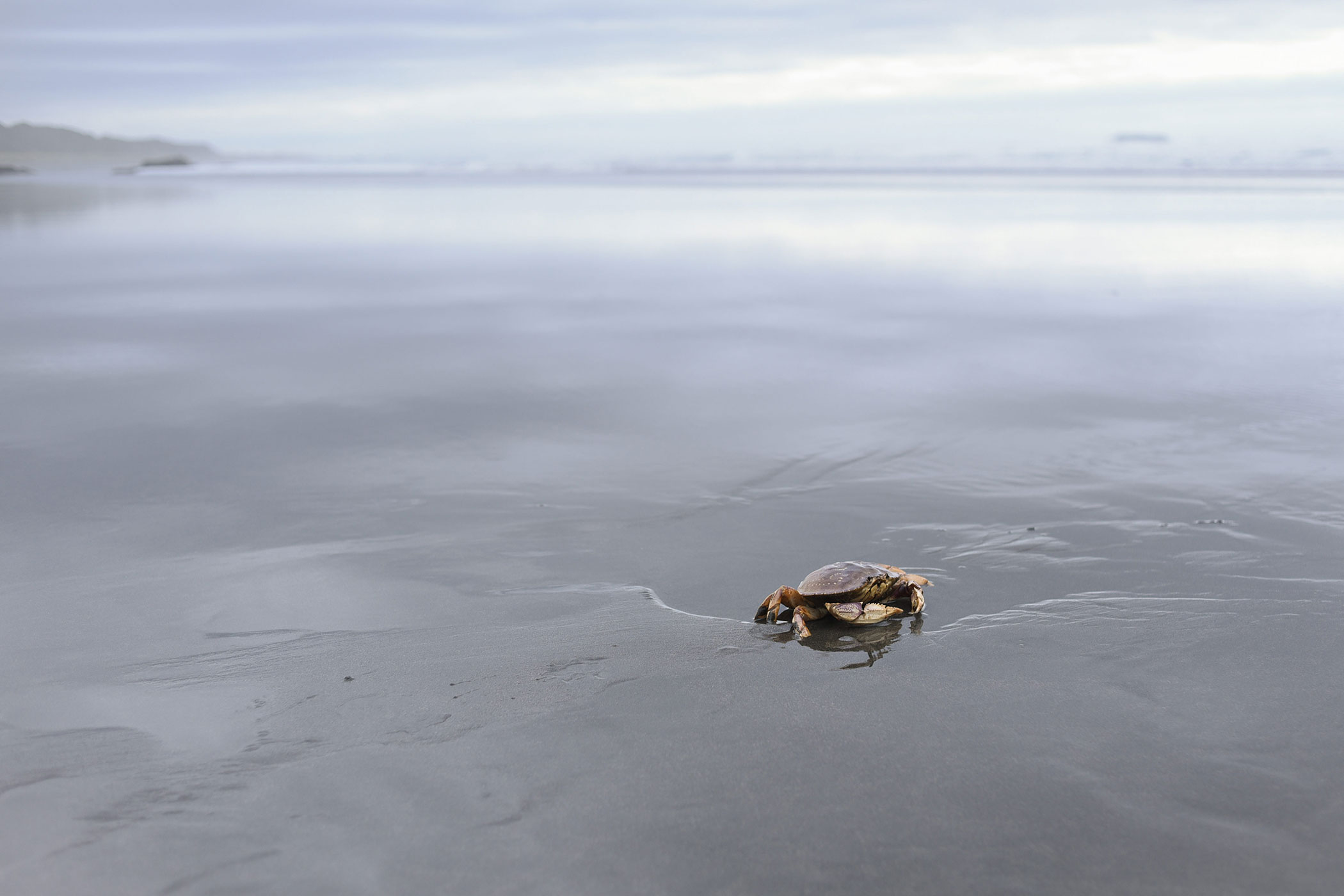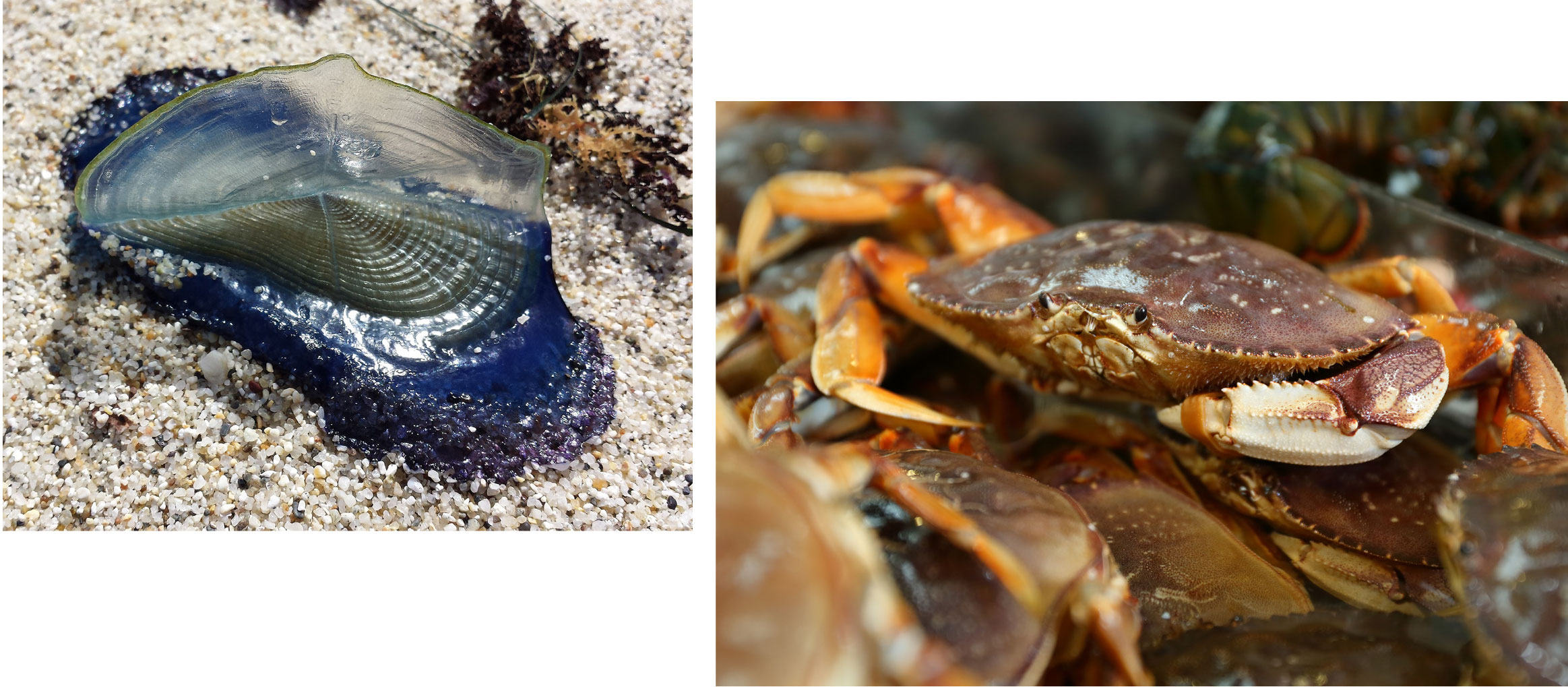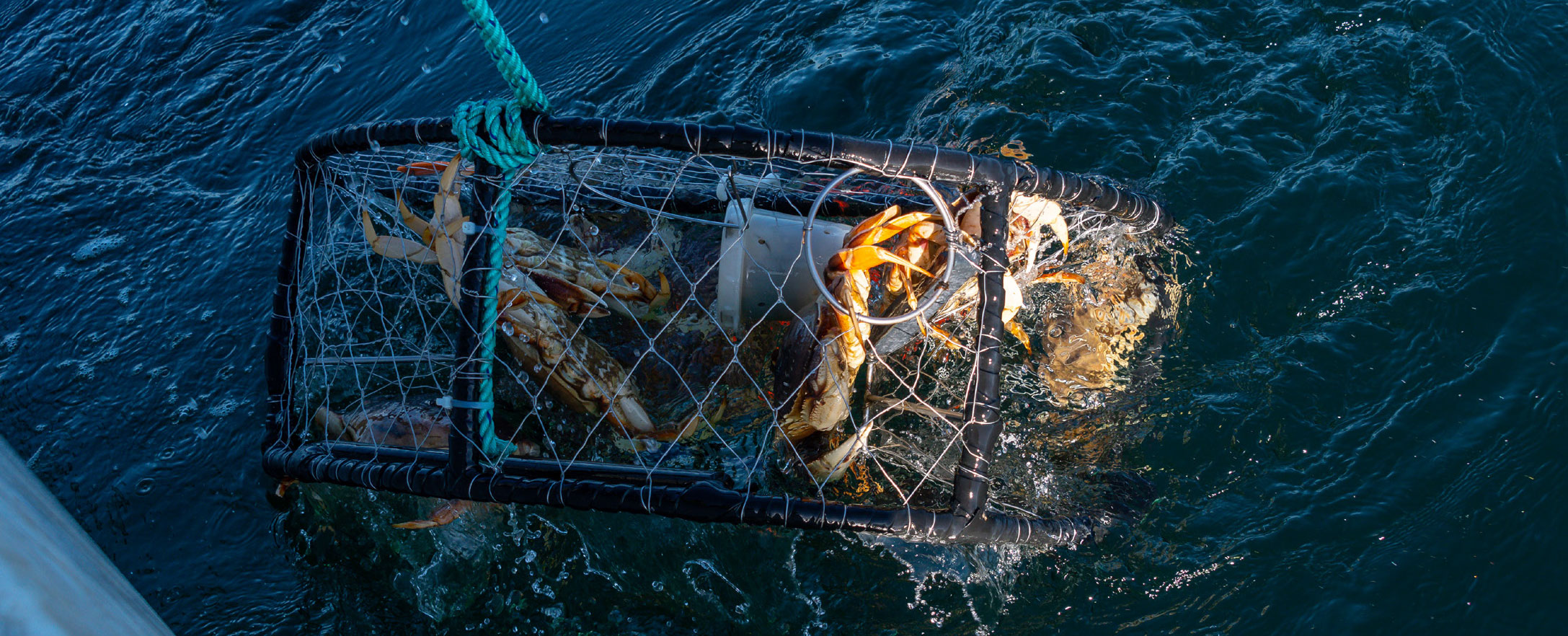Full Text
It’s a fish story with a happy ending. At least for now.
On the US West Coast, the Dungeness crab (Cancer magister) fishery supports a valuable annual harvest of seafood. And, year after year, it’s a fishery that keeps on giving.
In the last few decades, fishers from California to Washington have caught almost all available legal-size male Dungeness crabs each season. Yet, the crab population has remained stable or increased, according to a new population estimate of US West Coast Dungeness stocks.
“Catches and abundance, in central California especially, are increasing,” said Kate Richerson, a researcher at NOAA’s Northwest Fisheries Science Center in Seattle. “There’s reason to be optimistic that this fishery will continue to be one of the most productive on the West Coast.” Richerson is the lead author of a paper published in February in the journal Fisheries Research.
Other studies have suggested that, in the future, ocean acidification and climate change could impact the West Coast’s signature shellfish. That’s a concern, Richerson said, but the group’s work didn’t detect obvious signs of population-level impacts—yet.
|
|
From Eelgrass Bed to Market
Dungeness crabs live in eelgrass beds and other benthic habitats along the west coast of North America. They range from Unalaska, Alaska, to Santa Barbara County, California. Scientists think that all Dungeness crabs on the contiguous US West Coast are one evolutionary population.
The crabs play an important role in the California Current ecosystem as predators of bivalves and other benthic species, and as prey, with megalopae (the last larval stage) important in the diets of rockfish, salmon, and other fish, write Gilbert Pauley et al. in Species profiles: Life histories and environmental requirements of coastal fishes and invertebrates (Pacific Northwest): Dungeness crab. According to Pauley, eight coho salmon feasted on a combined 1,061 megalopae. A single fish consumed another 1,500 megalopae.
In Washington State waters, megalopae are most abundant in May and June. In Oregon, they peak in April and May. Larval development begins later moving north.
After molting into juveniles, the tiny crabs hitch rides on ocean bottom currents into estuaries, where they remain for 11 to 15 months. Dungeness crab growth proceeds in steps through a series of molts. At about four years old, most adult Dungeness males are market size.
A Prized Fishery
Dungeness crabs have been commercially harvested since the mid-1800s and today are one of the most profitable fisheries on the West Coast. They are caught in circular steel traps called pots that are baited with squid or razor clams. The average crab boat fishes 300 to 500 pots set in depths up to 180 m. After the pots are retrieved, crabs are kept alive in circulated seawater until they are delivered to shore-based processing plants.
In recent years, total West Coast Dungeness crab revenues have exceeded 200 million USD. “While C. magister landings have generally been trending upward since the 1980s,” Richerson et al. report, “it is unknown whether this is due to increased [fishing] effort, changes in abundance, or both.”
The researchers estimated pre-season abundance of the coastal population of legal-size male Dungeness crabs from 1970 to 2016 in California, and from 1982 through 2016 in Washington and Oregon. They found that the fishery takes 9% to 98% of the legal-size male population each year, averaging 66%.
Despite that high rate of exploitation, pre-season abundance appears to be stable or increasing in all areas, the biologists say. In central California, abundance rapidly increased over the past decade after a long period of low numbers. From 1950 to 1980, catches in northern California, Oregon, and Washington followed decadal cycles. Catches in central California also fluctuated. Since 1980, central California “landings don’t appear to have a strong periodicity,” the researchers found.
Some scientists believe the change could be linked with an increase in the crab fishing fleet’s capacity. But Richerson and colleagues say that “environmental and biological factors, rather than harvest, are the most likely drivers.”
Those drivers include the El Niño-Southern Oscillation, the Pacific Decadal Oscillation, and the timing of the spring transition. The spring transition, an annual shift of coastal winds and currents, is linked to the number of megalopae returning to the shallows to settle after their pelagic stage. That translates to commercial catch numbers four years later.
|
|
Ticket to Fish
Richeron’s main data source in Washington and Oregon was “fish tickets,” or landing receipts, from the Pacific States Marine Fisheries Commission’s PacFin database. In California, fish tickets were obtained from the California Department of Fish and Wildlife.
Fish tickets note the date, port, species, gear, and weight of catch landed by a commercial vessel. In California and Washington, a description of the catch area is included. In Oregon, only the state where the catch was made is recorded. “Fish tickets cover virtually all commercial landings and thus can be considered an unbiased measure of total catch,” write the scientists.
They also used information from logbooks kept by crab fishers in Oregon and Washington. The logbooks contain information on the number of pots, depth, estimated catch weight or numbers, and other variables. In Oregon, logbooks cover 78% to 96% of the total weight landed; in Washington, logbooks include almost all landings, excluding tribal landings.
Secret to a Successful Fishery
The success of the Dungeness crab fishery may lie in fishing regulations that protect the crabs’ reproductive potential. Male Dungeness crabs mature and begin reproducing one to two years before they can be caught. Female Dungeness crabs can store sperm for more than a year, allowing them to reproduce even in the absence of numerous males. Fishers must return females to the water, further protecting the reproductive capacity of the population.
West Coast states manage the fishery under a “3S” system: size, sex, and season. Only males with carapace widths greater than 159 mm may be harvested. In central California, the fishery for Dungeness crab usually opens in November; in northern California, Oregon, and Washington, in December. At the start of the season, fishing is intense, with the majority of the total catch often landed in the first six weeks. In summer or early fall, the fishery closes to protect the males during their molt.
“The management system for Dungeness crabs seems to be a perfect fit for their life history because it allows the population to reproduce and grow even with an intensive harvest,” says Richerson.
Crab numbers and reproduction rates vary from year to year, according to Richerson, mostly because of ocean conditions. In central California, numbers have risen over the last two decades, perhaps related to trends in the spring transition, and now average nearly five times the abundance estimates from 1970 to 2000.
Central California crab numbers have increased enough that they are closer to those of Dungeness populations in northern California, Oregon, and Washington, the researchers say. The latter populations don’t show the same growth trends as in central California, but are stable overall.
A previous increase in central California landings from the 1930s to the late 1950s was followed by a dramatic crash about 1960. Catches remained low until the 1980s, then rebounded. Biologists believe the jump reflected changing ocean conditions—and could happen again. The recent increase in central California crab abundance may be reversed when the system again shifts to a period of later spring transitions, scientists say.
The central California population is at the southern end of the C. magister range, so changes in ocean ecosystems may have a large impact on the return of larvae, “especially in years when a later spring transition leads to more northward transport of megalopae,” state Richerson et al.
Increasing water temperatures in the region may affect larval recruitment success by disrupting the timing of reproduction, according to the Dungeness Crab Enhanced Status Report of the California Department of Fish and Wildlife, published in November 2019. “Adults may move to deeper waters, causing females to extrude eggs earlier in the year. That may shift larvae outside the critical upwelling period that drives their nearshore transport.”
Scientists are modeling future sea surface temperature scenarios expected by 2080 and comparing them to historical Dungeness crab landings and ocean conditions in the California Current (lagged three to five years to represent larval recruitment). Results indicate detrimental impacts to the future fishery from ocean warming, with the most significant changes occurring with decreasing latitude.
Dungeness crabs, like other cold water species, may contract their southern geographic range. In the long term, the central California fishery may have reduced production, according to the status report.
Canary in the California Current
Future changes in the California Current ecosystem may alter the Dungeness crab population and “the effectiveness of the current management regime,” states Richerson. Harmful algal blooms, especially of the diatom Pseudonitzschia, which produces toxic domoic acid, have affected the fishery. The blooms are linked with warming ocean waters.
The opening of the commercial Dungeness fishery was delayed during the 2015–2016, 2016–2017, and 2018–2019 fishing seasons to mitigate human health risks as a result of high domoic acid concentrations from harmful algal blooms. A federal disaster was declared for the 2015–2016 season due to a four-month delay in the fishery opening, resulting in a shortened fishing season and lost revenue.
Beyond harmful algal blooms, human influences are likely to increase hypoxia and ocean acidification in the California Current System, “which may impact the growth, survival, distribution, and/or population size of C. magister,” Richerson et al. write. “Increased frequency of these events and other threats to the fishery have the potential to greatly impact fishers and fishing communities.”
Hypoxic zones in shallow, nearshore environments will likely increase with rises in ocean temperature. Large-scale hypoxia developed during the summers of 2006 and 2007, with scores of Dungeness crabs washing ashore along the Oregon coast. Benthic-dwelling nearshore organisms like Dungeness crabs are especially susceptible to hypoxia. If the zone of depleted oxygen develops quickly or is large, crabs may not be able to escape in time.
|
|
Whales vs. Crab Fishers?
The Dungeness crab fishery faces another challenge: whale entanglements in fishing gear. The issue resulted in an early closure of the California fishery in 2019.
Since 2014, whale entanglements have sharply increased along the US West Coast, especially “entanglements between humpback whales and commercial Dungeness crab gear,” report Kaitlin Lebon and Ryan Kelly of the University of Washington in a 2019 paper in Global Ecology and Conservation.
“Whales may come into contact with fishing gear because of unfamiliarity with it, difficulties detecting certain shapes or materials in the water column, or because their health or oceanographic conditions inhibit their sensory abilities,” Lebon and Kelly state.
Entanglement is an all-too-common event for many whale populations. Some 72% of North Atlantic right whales on the US East Coast have scars from entanglements. Even populations in remote Arctic waters show impacts, with 10% of bowhead whales taken by subsistence harvesters having rope scars from pot or trap fishing gear.
Lebon and Kelly compared alternative ways of reducing entanglements and found “a small number of high-ranking policy options.” Among them: Galvanic Timed Releases (GTRs), devices that keep lines submerged until crab pots are ready to be picked up. GTRs minimize the time crab pot lines are in the water.
Fixed-gear fisheries in Australia and New Zealand use GTRs. GTRs are inexpensive, Lebon and Kelly found, and help keep vertical float lines out of the water column until fishers can retrieve their pots. Anchoring float lines near crab pots eliminates the possibility of whales encountering the lines.
GTRs, the researchers say, are one more way to help this fish story keep its happy ending.




